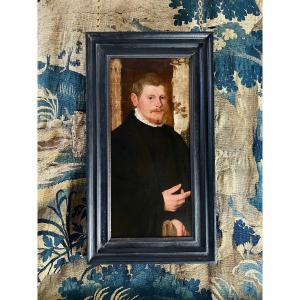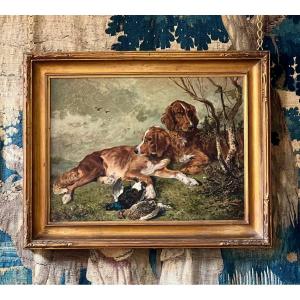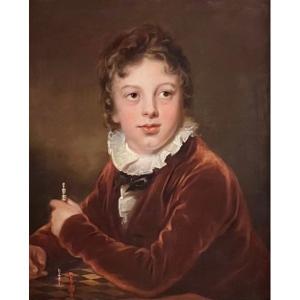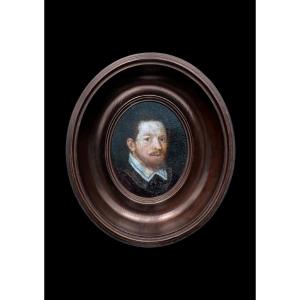The elegant sitter is depicted three quarter length between foliage against a stormy sky and military encampment. His left hand is in his pocket, whilst his right hand grasps his sword, and his hat is tucked in his arm. With his head and eyes are averted away from the viewer, he gazes off as if lost in thought.
We know that this gentleman is an infantry officer as his uniform is cut according to the 1768 Clothing Warrant, and his costume is comprised of a scarlet coat with black facings and silver paired buttons, worn over a frilled white shirt, grey waistcoat and silver gorget which glistens in the light.
It is likely that this officer is a Militia officer because his buttons are not numbered and also because his sword knot. From 1767 regiments were ordered to number their buttons with their regimental precedence number and these could appear in Arabic or Roman numerals, but there are none here. His silver lace knot with black stripe is also not of the type worn by officers since at least 1751 by regular officers.
Militia, part-time soldiers officered by the local land-owning class and organised by county or, in the case of Yorkshire, by Riding. The Militia was for Home Defence only and could not be sent overseas. It was “embodied” - called out for active duty - during wartime and, in combination with those Regular regts that remained in GB, it constituted the army that would repel any invasion from France. After the French and Spanish joined in the American War of Independence in 1778, the Militia was embodied and did not stand down until early 1783.
During the Summer both Regulars and Militia went into camps of exercise strategically positioned in Kent and Essex in order to be on hand to repel invasion. The background shows exactly the sort of encampment that one would expect.
Of particular note here are the rose the officers lapel as well as the heart-shaped jewel on his shirt ruffle. The Regular regiments that fought the battle of Minden in 1759 always (and still do) wear roses in their buttonholes to commemorate that date, but no regt at Minden had black facings.
I would suggest that this may well be a marriage portrait, a rare survivor, charged with emotion, which refers to a private matrimonial event.
Tilly Kettle (1735–1786) Kettle was a portrait painter and the first prominent English portrait painter to operate in India. He was born in London, the son of a coach painter. He studied drawing with William Shipley in the Strand and first entered professional portraiture in the 1750s.
Kettle's first series of portraits appeared in the 1760s. His first surviving painting is a self-portrait from 1760, with his first exhibit with the Free Society of Artists in 1761. In 1762, he worked at restoring Robert Streater's ceiling paintings in the Sheldonian Theatre, Oxford, and painted Francis Yarborough, a doctor of Brasenose College, Oxford in 1763. He painted many members of the family of William Legge, 2nd Earl of Dartmouth. In 1764-5, he was active in London and continued exhibiting at the Society of Artists.
In 1768, Kettle sailed to India with the British East India Company, landing at Madras, where he remained for two years. There, he painted Lord Pigot and Muhammad Ali Khan twice (once alone and once with five of his sons). In 1770 Kettle painted a half-length portrait of 'Sir' Levett Hanson, a peripatetic writer on European knighthood and chivalry originally from Yorkshire. (The portrait is now in the collection of the Bury St Edmunds Manor House Museum.)
Kettle moved on to Calcutta in 1771. In 1775, he painted George Bogle, Warren Hastings' emissary to Tibet, in Tibetan dress, presenting a ceremonial white scarf to Lobsang Palden Yeshe the 6th Panchen Lama. He also took an Indian bibi or mistress and had two daughters by her, Ann and Elizabeth.
He left India in 1776 for London, travelling on the ship Talbot. On his return, he swiftly married Mary "Polly" Paine (1753–1798) on 23 February 1777. Mary was the younger daughter of the architect James Paine and half sister of the sculptor James Paine. She brought a dowry of £5,000, while Kettle put up £3,000 toward a trust fund, set up in a pre-nuptial settlement, dated 22 February 1777, the day before their wedding, so both parties were well established. The couple had two children, a daughter, Mary, and a son, James. At the same time, he switched his exhibitors to the Royal Academy of Art.
Kettle had fewer clients in England than he had before his departure, and contemporaries claimed his wife was financially imprudent. He fell into debt, and spent some time in Ireland to escape his financial problems. In 1786 he set out for a return to India. He attempted the voyage overland through Asia. His last portrait, The Turkish Janissary of the English Factory, Aleppo, was painted in Aleppo, and he died some time later, although where and when is unclear, possibly in the desert on his way to Basrah before the end of 1786.
This fine work is in an excellent state of conservation, and is ready to hang and enjoy in its likely original carved black wooden frame with gilt highlights.
Provenance: Private collection New England USA.
Higher resolution images on request.
Worldwide shipping available.
Canvas: 38 x 30 in / 97cm x 76.5cm
Frame: 44 1/2 x 38 in / 113cm x 97cm
I am exceedingly grateful to Dr Andrew Cormack for his invaluable assistance in helping to identify this portrait.













































 Le Magazine de PROANTIC
Le Magazine de PROANTIC TRÉSORS Magazine
TRÉSORS Magazine Rivista Artiquariato
Rivista Artiquariato